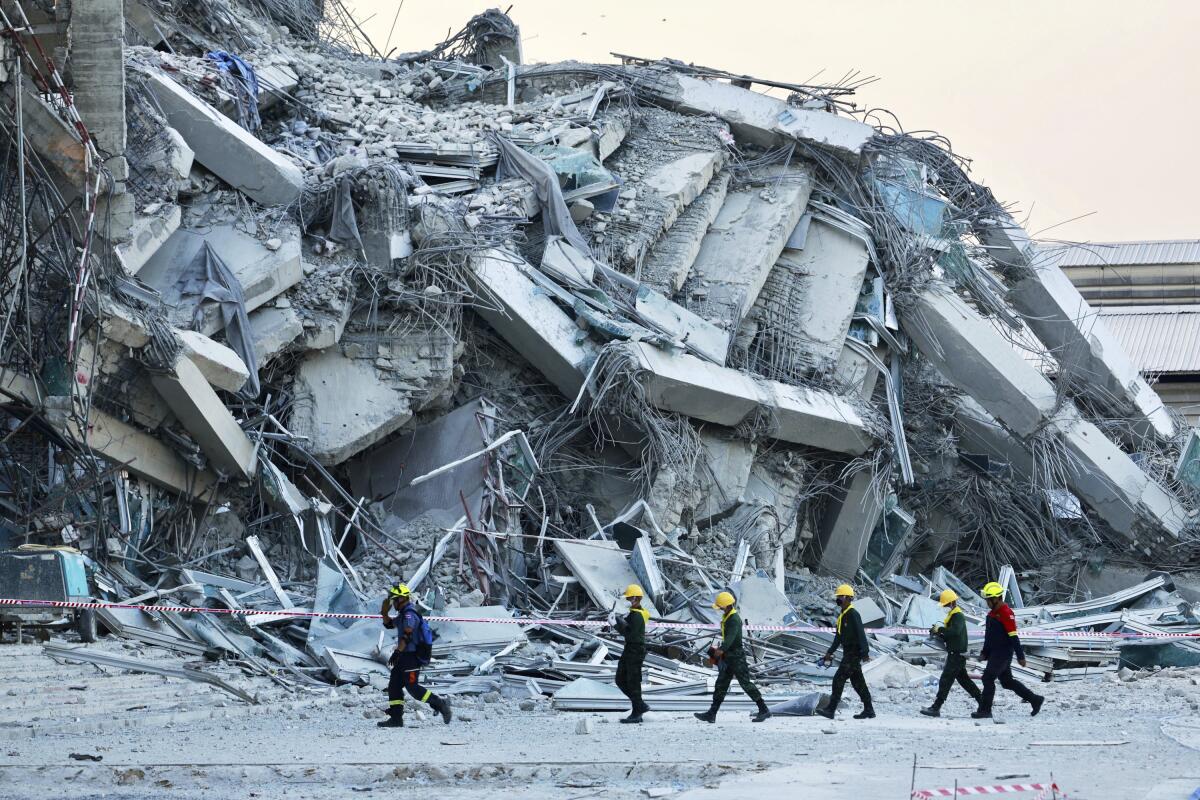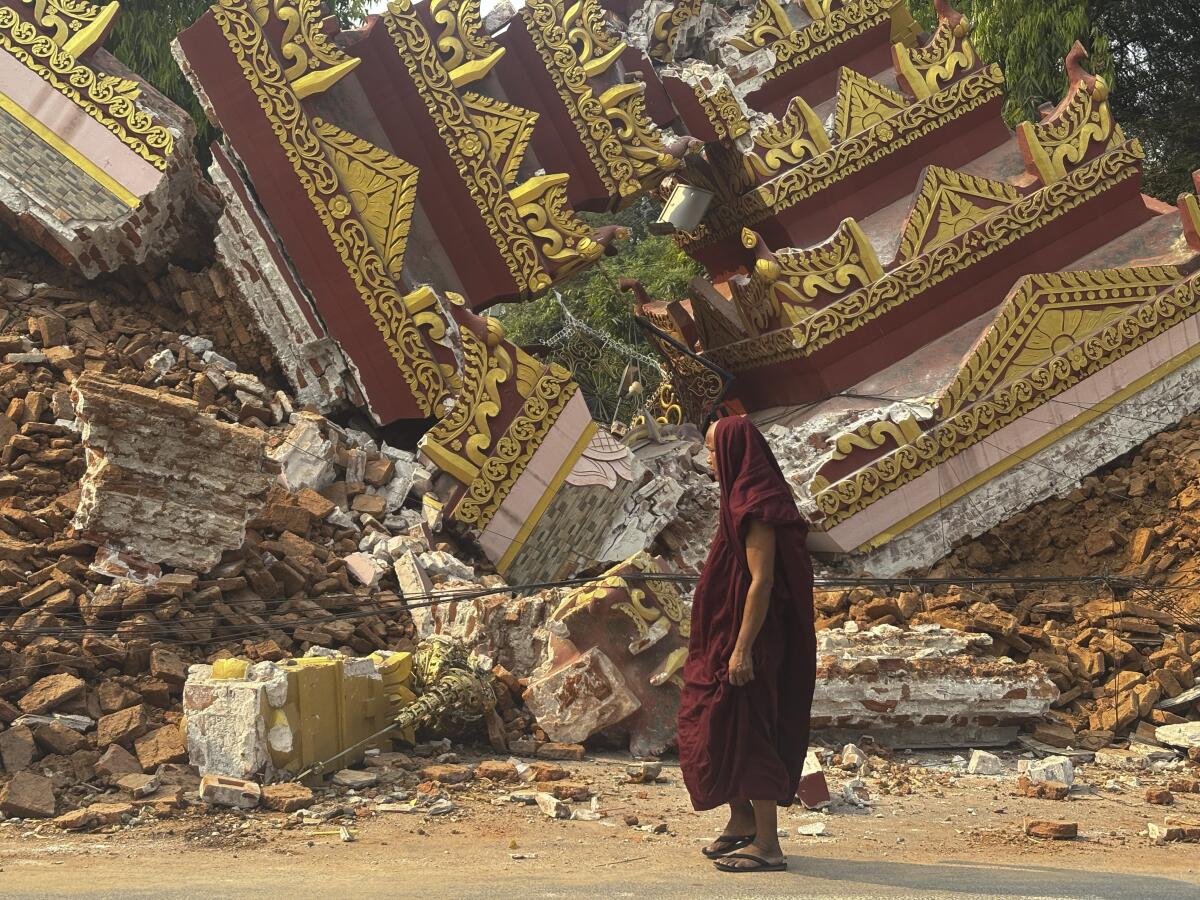What could the next mega-earthquake on California’s notorious San Andreas fault look like?
Would it be a repeat of 1857, when an earthquake estimated at magnitude 7.7 to 7.9 ruptured the fault from Monterey County all the way through Los Angeles County? Would it be more akin to the great 1906 San Francisco earthquake, which began just offshore of the city and ruptured in two directions, toward Humboldt County and Santa Cruz County?
Don’t bet on an identical sequel.
That’s the implication of a study published Monday in the journal Proceedings of the National Academy of Sciences. The report, coauthored by scientists at Caltech in Pasadena, studied a massive earthquake that ruptured in the southeast Asian country of Myanmar on March 28 — on a fault known for being eerily similar to the San Andreas.
The earthquake ended up rupturing a much longer section of the fault than scientists expected, given the seismology of the region.
The implications of this study are that “earthquakes never come back exactly the same way,” Solene L. Antoine, a postdoctoral fellow at Caltech and the study’s lead author, said in an interview.
A local man drives a motorbike past a damaged building, in the aftermath of an earthquake in Naypyidaw, Myanmar, on March 30.
(Aung Shine Oo / Associated Press)
“It came as a surprise that you could get such a long rupture,” said Jean-Philippe Avouac, a coauthor of the study and a professor of geology and mechanical and civil engineering at Caltech.
March’s Mandalay earthquake devastated Myanmar, killing at least 3,791 people and an additional 63 people in Thailand. High-rise buildings were damaged as far away as Ho Chi Minh City in Vietnam and homes were damaged in the Ruili area of China. Damage was estimated at $1.9 billion, according to the U.S. Geological Survey.
It was the most powerful earthquake in Myanmar in at least 79 years.

“Violent” and “extreme” shaking, shown in red, was felt all along the 317 miles of the ruptured Sagaing fault in Myanmar during a magnitude 7.7 earthquake in March.
(U.S. Geological Survey)
The magnitude 7.7 earthquake ruptured an astonishing 317 miles of the Sagaing fault, a finding based on Antoine’s analysis of satellite data showing earth movement after the quake. That’s the longest seismic rupture ever documented on a continent.
By comparison, California’s 1906 earthquake ruptured 296 miles of the San Andreas fault; and the 1857 earthquake, 225 miles. Longer seismic ruptures have been found only on subduction megathrusts deep underneath the ocean.
What’s clear from the study is that while California’s next “Big One” may share some characteristics of previously documented devastating quakes, it’s unlikely to be an exact replay. As the recent experience in Myanmar shows, even well-documented faults can behave in surprising ways.
The next step is to develop a model simulating earthquakes over many millennia for the San Andreas fault, which the authors plan to do in the future. But the San Andreas fault “is far more complex,” Avouac said. “It’s not going to come soon, because it’s quite a heavy calculation.”
Still, such simulations would provide a model of “all possible scenarios so that we have a better view of the range of possible ruptures that could happen.”

Rescuers work at the site of a high-rise building under construction in Bangkok, Thailand, that collapsed after a magnitude 7.7 earthquake centered in Myanmar on March 28.
(Wason Wanichakorn / Associated Press)
For instance, maybe the San Andreas fault will rupture in smaller, separate earthquakes, Avouac said.
Or it could be a much larger earthquake — rupturing the fault not just from Monterey to Los Angeles counties, but perhaps all the way into San Bernardino, Riverside and Imperial counties, which would possibly exceed magnitude 8. Such a quake would be the largest simultaneous disaster in modern California history, with huge swaths of the state wracked by powerful seismic shaking all at once.
By comparison, the 1994 Northridge earthquake’s footprint was relatively constrained, severely affecting only a portion of Los Angeles County, especially the San Fernando Valley — related to its relatively smaller magnitude of 6.7.
But while modeling previous activity on the San Andreas fault will provide a glimpse into the wide range of possible outcomes, it will not pinpoint precisely when the next great quake will strike.
“We can’t just expect the exact same thing to happen,” Antoine said. “It is a matter of just showing what scenarios are possible, the diversity of scenarios and seeing what are the consequences of each of those scenarios.”

A Buddhist monk walks near a collapsed pagoda on March 30 after an earthquake in central Myanmar.
(Thein Zaw / Associated Press)
Sometimes, Avouac said, “it’s quiet for a long time, nothing happens … stress is building up, the fault is locked for a long time, nothing happens, and then, boom, you have a large earthquake.”
“And then you have other periods during which you have a lot of [seismic] activity, but these earthquakes are all smaller,” Avouac said.
But “smaller” earthquakes, in the minds of researchers, are still big to the layperson. In the study’s simulations, there are periods where earthquakes around magnitude 7.7 are common. In other periods, earthquakes max out at magnitude 7.5 or so, but are more frequent.
The entire length of the Sagaing fault — including areas that didn’t rupture in the March earthquake — is 750 miles, north to south, from the Himalayas to the Andaman Sea, and helps accommodate the northward push of the Indian tectonic plate.
The fact that 317 miles of the Sagaing fault ruptured in March was surprising to scientists. Only about 170 miles had been quiet seismically for more than a century, having last ruptured in 1839.

(Solene Antoine / Caltech)
Scientists call these “seismic gaps” — particular areas of a fault that haven’t recently ruptured.
Generally, scientists would’ve expected only this long-dormant 170-mile piece of the Sagaing fault to rupture, Avouac said, but not more recently ruptured sections. That includes a 100-mile stretch that ruptured in large earthquakes in 1929 and 1930, and a 50-mile stretch that went off in a pair of quakes in 1946 and 1956.
Instead, even those fault segments ruptured in the big March earthquake.
So what gives?
A possible explanation is the Sagaing fault’s extraordinary smoothness. “And people have observed that when the fault is very smooth, the rupture … tends to propagate at a velocity” so fast that it results in an “extremely elongated rupture,” Avouac said.
The study also published the results of a computer model simulation looking at how earthquakes might rupture along sections of the entire 750-mile long Sagaing fault. The code, developed by study coauthor Kyungjae Im of Caltech, suggests that over a hypothetical 1,400-year period, there would be no repeatable patterns.
In other words, earthquakes didn’t seem to re-occur like clockwork, rupturing the same stretch of fault in a repeatable, predictable pattern.
“There is complexity here. And this is because each time you have an earthquake, it redistributes the stress on the fault, which is going to influence the next earthquake,” Avouac said. “There’s a self-induced complexity in the process, and that leads to a bit of randomness.”
There is one certainty, which is bound to disappoint anyone who shares the hope that a “Big One” simply won’t ever strike California again.
“There will be an earthquake at some point,” Antoine said. “If there is stress building up on the fault, the fault won’t hold forever.”
Further research and observations are essential to refine models of future possible earthquakes, including from the Sentinel satellites, which are operated by the European Space Agency, the authors said.
The other coauthors of the study are Rajani Shrestha and Chris Milliner of Caltech; Chris Rollins of Earth Sciences New Zealand; Kang Wang of the Washington-based EarthScope Consortium; and Kejie Chen of the Southern University of Science and Technology in Shenzhen, China.
This story originally appeared on LA Times

